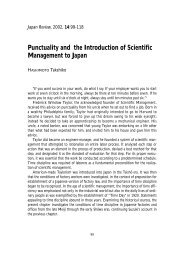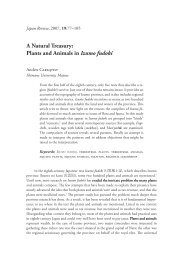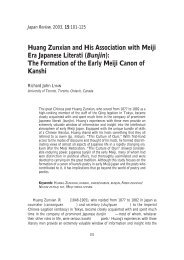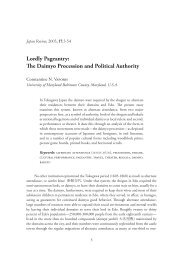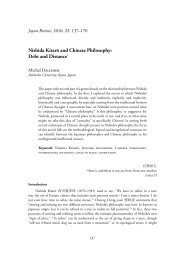Meiji shinkyoku - 国際日本文化研究センター
Meiji shinkyoku - 国際日本文化研究センター
Meiji shinkyoku - 国際日本文化研究センター
You also want an ePaper? Increase the reach of your titles
YUMPU automatically turns print PDFs into web optimized ePapers that Google loves.
110 Philip Flavin<br />
high level of education, not only in terms of diction and lexicon, but in terms of cultural and<br />
historical knowledge as well. An appreciation of the poetry used in the koto kumiuta Jichō 二長,<br />
for example, required knowledge of Buddhist mythology, and Chinese history and mythology,<br />
while the koto kumiuta Ukifune 浮舟 assumed an intimate knowledge of Th e Tale of Genji. Given<br />
that most jiuta texts focused on Edo period culture, they would have been more accessible to<br />
the <strong>Meiji</strong> audience. With the new <strong>Meiji</strong> morality, however, those that dwell on the idealised<br />
romance of the fl oating world may have seemed inappropriate or simply old-fashioned. With<br />
its references to contemporary events and ideas, Mikuni no homare must have been a refreshing<br />
change for the <strong>Meiji</strong> consumer. 32<br />
A paean to the emerging nation, Mikuni no homare celebrates the <strong>Meiji</strong> state, the return to<br />
imperial rule, the formation of a centralized government, and Japan’s interaction with foreign<br />
powers.<br />
「御国の誉」<br />
神の代の光変はらで日の本のげにありがたき大君の昔に還る政事鄙も都も<br />
明らかに治まる御代の秋津国水も魚との君と臣<br />
手事<br />
異国かけて交はりもなほ年ごとに開け行く民ゆたかなる豊年に神の恵みの<br />
現はれて国の御稜威は尽きせじな国の光は絶えせじな<br />
Mikuni no homare<br />
Kami no yo no / hikari kawarade hi no moto no / ge ni arigataki ōkimi 33 no / mukashi ni<br />
kaeru matsurigoto 34 / hina mo miyako mo akiraka ni / osamaru miyo no Akitsukuni 35 / mizu<br />
to uo to no kimi to tami<br />
tegoto<br />
kotokuni kakete majiwari mo / nao toshigoto ni hirakeyuku / tami yutaka naru toyotoshi<br />
ni / kami no megumi no arawarete / kuni no mi’izu wa tsukiseji na / kuni no hikari wa<br />
taeseji na<br />
In Praise of the Empire<br />
Th e light of the Age of the Gods shines undimmed; returned to ancient rule with the<br />
emperor, our benevolent lord, beneath the sun, the administration of the realm governs<br />
with clarity both country and city in the land of Yamato in this imperial age. Th e lord<br />
and his people are as water and fi sh.<br />
Interlude<br />
Exchange with foreign countries develops with each passing year, the people are blessed<br />
each year with riches. As the blessings of the gods appear, the imperial authority shall<br />
never fail, and the light of the country never vanish. 36<br />
Why Kikutaka composed this particular text is unknown. Nonetheless, for the purpose<br />
of popularisation, Kikutaka’s selection was as astute as his choice of musical material. All of the<br />
images—the establishment of an imperial government, the restration of the emperor, Japan’s<br />
interaction with foreign powers, the benevolent and paternalistic image of the emperor as the sea<br />
nourishing his subjects, the emphasis upon an eternal imperial authority—were ideals promoted<br />
by the <strong>Meiji</strong> oligarchy, familiar to populace and of immediate interest and concern. Even more<br />
important is the new awareness of Japan as a nation state, as a unique entity interacting with



